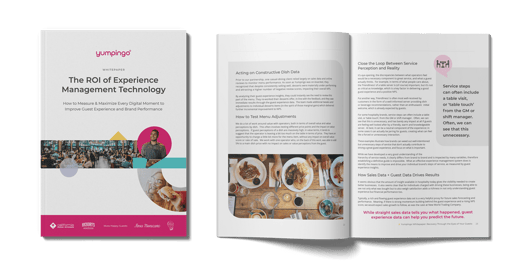Understanding Customer Experience in the Hospitality Industry
In the hospitality industry, the customer experience is everything. It’s a journey that starts with a guest’s awareness of your brand and develops through every customer touchpoint, creating brand equity that drives everything from positive online reviews to repeat visits.
But what is ‘customer experience’? Anytime customers invest time or money into a business, they expect a certain level of satisfaction. For your hospitality business, it’s a mindset that extends far beyond a warm welcome and a friendly smile. It encompasses every point of contact with your guests, including your website, your social media accounts, and your wider online presence.
If you can understand your guest’s perception of your brand then you can start to create interactions that meet and exceed their expectations. Want to drive customer loyalty and brand advocacy? You’ll need to build meaningful, end-to-end customer experiences.
What is Customer Experience Management?
The customer experience is at the heart of everything you do. As a hospitality professional, you already understand the importance of great service, impeccable venues, and personalized interactions — the moments that truly “wow” your guests and leave them craving more.
But the modern customer experience is fundamentally different than it used to be. There are so many more touchpoints, so many more moments that influence your potential guests to either become advocates or detractors for your brand. If you don’t believe us, just take a look:
The Google Search: Potential guests look up your business online, so you need to make sure your website is well-established and provides an aesthetically pleasing experience.
Checking Social Media: After they find your business’s website, potential guests check social media to see what people are saying about their experiences. This is important because 92 percent of consumers trust word-of-mouth recommendations over advertising.
Checking Review Sites: Online reviews can keep guests flocking to your doors, or they can keep guests from ever considering a visit. Research shows 84 percent of people trust online reviews just as much as personal recommendations. Restaurant businesses need to track these sites but it can be a difficult, tedious process when done traditionally.
The Dining Experience: This is it — your chance to delight your guests and provide them with the great experience that will turn them into an advocate for your business and a loyal customer. As a business owner, it’s also your opportunity to collect feedback and capture invaluable data at the height of that guest’s delight. That’s why brands should consider investing in customer experience management solutions that empower your guests to interact with your brand through multiple channels.
Leaving a Review: There are now multiple platforms for guests to leave a review of your brand and provide feedback. The way you monitor feedback can help you manage customer expectations and derive insights that help you improve every aspect of your business.
Periodic Notifications to Create Return Guests: Gartner reports 80 percent of future revenue will come from 20 percent of your customers. Businesses that build a lasting connection with their guests increase the odds of return visits and higher ticket amounts.
Customer experience management technology like Yumpingo, which is designed specifically for hospitality businesses, can help refine your business’ customer experience, and even create new ones. By capturing and measuring guests’ interactions at every stage of their journey, you gain the visibility needed to understand how your brand is performing — directly from the voice of the guest.
Experience management solutions can cut through the noise of the many different channels and distill all of that information into actionable insights. That way, teams can fully understand their impact on the customer experience and what they need to do to improve. Consolidating the insights into a single unified view simplifies the execution process by giving teams a comprehensive view of the end-to-end experience. With the data captured at each point in the journey, you’ll have a clear understanding of where you aren’t meeting guest expectations. From a salty dish to an overly attentive server, simply assess what drove satisfaction levels off track so you can proactively drive consistencies throughout the experience.
By understanding what your guests want and expect from your business, you can make better decisions much faster.
How Can Your Brand Improve the Customer Experience?
A sound customer experience management strategy will help you gain valuable information about how your guests interact and connect with your brand. But it’s up to restaurant owners and operators to get creative with that strategy to provide a unique, individual experience for every person who walks through your door – whether it’s in-store traffic or online traffic.
Prioritize Guest Safety
Given the world-changing events of the past year, it should come as no surprise that ensuring guest safety is a key component of improving customer experience. Contactless ordering and payment technologies via QR code are now standard guest expectations, so why not gather guest feedback the same way? Technologies like Yumpingo Central provide QR code solutions that empower your guests to provide feedback instantly from their own devices, without ever feeling like their safety is being compromised with shared technology.
Identify Key Touchpoints
If you want to improve the experience guests have with your brand, start by identifying the moments that matter. What interactions are great and could be even better – and why? What are the pain points that you can turn into opportunities to create unique interactions your guest will never forget?
Don’t Drop the Ball with Delivery
The pandemic forced many restaurant businesses to refine their delivery operations. If you were struggling to become master of your delivery domain pre-COVID, odds are you have a much better understanding of it now. There will continue to be high demand for delivery going forward, so it’s vital that you have your employees trained on the appropriate processes and trust your provider. Order accuracy and food quality are the top takeout purchase drivers, with 44 percent of consumers saying accurate orders influence their restaurant choice.
Personalize, Personalize, Personalize
Hyper-personalization is another critical aspect of improving your customer experience. But if you want to create those truly memorable interactions — the ones that will really “wow” your guests — you need to stop thinking of personalization as a buzzword.
For example, if you’ve switched to delivery services during the pandemic, include something with each order to remind your guests that you can’t wait to see them back in your brick-and-mortar location soon (after all, a handwritten thank-you note goes a long way!).
How Do You Measure Customer Experience?
Did you know that customer-centric businesses are 60 percent more profitable than companies that don’t focus on customers? The correlation between happy guests and higher revenue is a compelling reason to regularly track how people feel about your brand.
But how do you measure and monitor customer experience? There are three key metrics your business needs:
Net Promoter Score (NPS)
NPS is your go-to tool when you want to take a snapshot of customer satisfaction and brand loyalty. By analyzing the responses to a single question — “How likely are you to recommend us to a friend?” — you can segment your guests into detractors, passives, and promoters.
Subtract the percentage of detractors from promoters to find your NPS. Anything above 30 is a competitive score in the hospitality sector. NPS is widely used because it’s simple to calculate, easy to understand, and scalable.
Customer Satisfaction Score (CSAT)
CSAT is a direct measurement of your guest’s satisfaction with your business and is a valuable metric for capturing the unique context of a customer experience.
A typical example of CSAT implementation would be an automated survey sent to your customer around 30 minutes after they pay their bill. Ask your guests to rate their experience on a 5-star scale to gauge their immediate response and get a useful snapshot of your performance.
Customer Effort Score (CES)
If you’ve been making efforts to smooth out pain points in the customer experience, CES will help you measure those efforts’ effectiveness. It’s also a great way of pinpointing weaknesses with actionable insights.
Yumpingo Delivers More Happy Guests
If you’re striving to create the ultimate experience for your guests, Yumpingo can help. Our hospitality-focused customer experience management solutions can help you connect to and influence every touchpoint on the guest journey.
Our software provides hospitality managers with unique clarity into the happiness of your guests. More importantly, Yumpingo also gives your managers insight into why your customers are happy (or not!). Yumpingo’s engine synthesizes that feedback into useful insights that give you and your managers the information needed to make better, more informed decisions that can improve customer experience, increase your NPS, and grow your ROI.
Download the ROI of Experience Management Technology white paper to learn other proven success stories of how brands are growing their experience management strategy to maintain a competitive advantage in the market.

Share this:
Subscribe to our Newsletter
You May Also Like
These Related Stories

Is it time to get hyper-personal with your guests?

Brand experiences for better not worse
